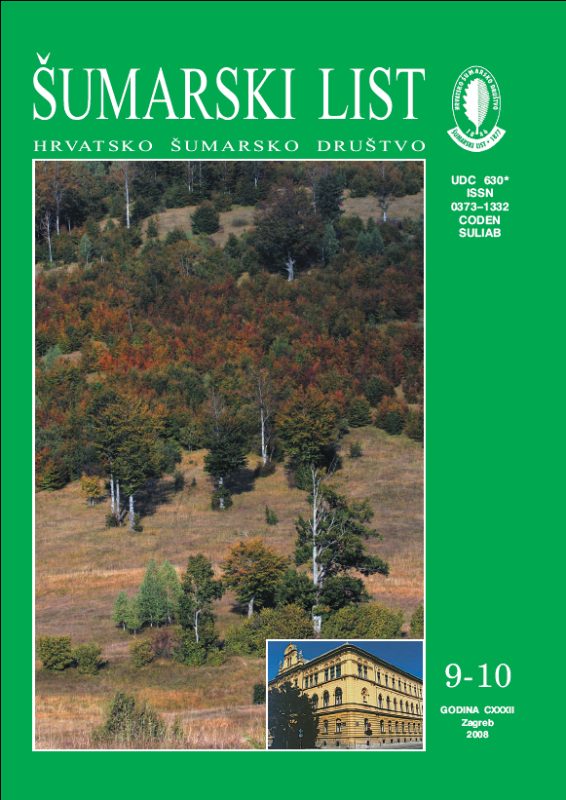
broj: 9-10/2008
pdf (14,1 MB) |
|
||||||||||||||
| RIJEČ GLAVNOGA UREDNIKA | ||
| Branimir Prpić | ||
| THE EDITORIAL BOARD AND THE AUTHORS OF THE ARTICLES IN “FORESTRY JOURNAL” RECEIVE SOME EXCELLENT NEWS PDF HR EN | 389 | |
| IZVORNI ZNANSTVENI ČLANCI | ||
| Seletković, A., R. Pernar, A. Jazbec, M. Ančić | UDK 630* 587 + 588 (001) | |
| Accuracy Of High Spatial Resolution Satellite Images Classification For Forestry Needs pdf HR EN | 393 | |
| Pernar, N., D. Bakšić, V. Bobić, I. Perković | UDK 630* 114.2 + 116 (001) | |
| Soil Condition in Microdepressions of Žutica Forest pdf HR EN | 405 | |
| Klobučar, Damir | UDK 630* 585 + 569 (001) | |
| Using Second order Histograms to Estimate Relative Stand Density pdf HR EN | 419 | |
| Ballian, D., B. Giersberg, U. Tröber | UDK 630* 165 (001) | |
| Genetic Variability of Common Yew (Taxus baccata L.) in Bosnia and Herzegovina pdf HR EN | 431 | |
| Summary: By biochemical markers, we analyzed the molecular genetic structure of a part of natural populations of Common Yew (Taxus baccata L.) in Bosnia and Herzegovina. For this analysis we used the material from 6 Yew populations. The genetic variability was analyzed by usage of 6 enzyme systems, and we successfully analyzed 6 gene loci who exhibited an adequate level of polymorphism. The analysis included a total of 16 allele. The average number of allele per locus varied between 1,83 and 2,33. By the analysis we determined that the presence of significant variability within the populations, that showed a discontinued character. A potential genotype diversity varied between 162 and 1944, and the number of potential polymorphous genetic loci varied between 66, 6 % and 83, 3 %. Gen pool diversity varied between 1,208 and 1,564, and average real heterozygosis between 0,185 and 0,490, while the overall average realistic heterozygosis was 0,281 for all populations. Based on the obtained results as a result we can make numerous remarks that are significant for carrying out the activities at protection of the autochthonous gene fund of the Yew. Thus, by the analysis of 6 isoenzyme gene loci there was determined the existence of statistically significant differences among the studied populations, and variability of the Common Yew that was determined have indicated discontinued variability. The differences were determined between the populations of Ozren and other populations, including significant differentiation among them, and their genetic distances were also considerable. The results of the analysis of the Yew from Bosnia and Herzegovina indicated the existence of specific allele in the studied populations, as opposed to the larch from central and northern Europe, which means that our larch could not be too far from its glacial stand. The populations are thus more resistant and less susceptible to degradation and drying, than the populations from the west as they possess sufficient genetic variability. Lower value of heterozygosis of the studied populations as opposed to the populations of the Yew from Central Europe show that the studied populations were under strong anthropogenic influence, however, they did not lose much of its adaptation genetic potential. If we analyze the heterozygosis of the gene loci 6-Pgdh – A, that is quite high, points at higher level of resistance of our Yew populations. In order to preserve natural genetic resources of Common Yew in Bosnia and Herzegovina, it is necessary to establish gene banks in situ and ex situ, which are necessary for preservation of the genetic diversity. In the activities with larch, and in its restoration, advantage should be given to its natural rejuvenation, with permanent monitoring of its genetic structure, in order to allow timely measures for preservation of optimal natural genetic structure that is typical for each separate population. Key words: Taxus baccata L.; isoenzymes; variability | ||


